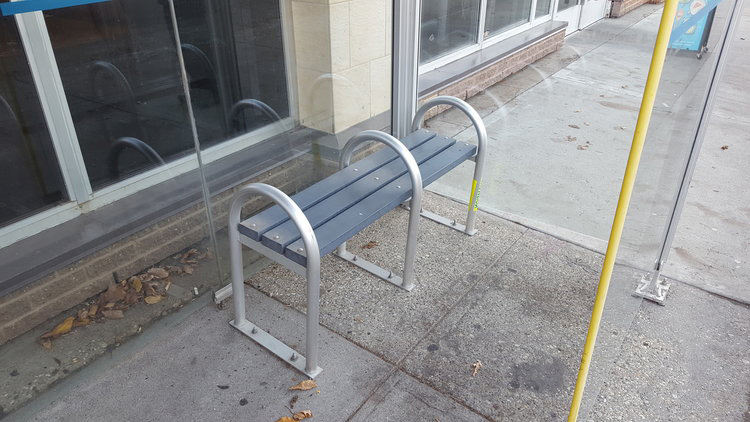 www.whoiswelcome.info
www.whoiswelcome.infoHostile design, sometimes called unpleasant design, is a kind of architecture that aims to prevent the use of certain aspects of the urban environment in ways that the designer deems unacceptable. Specifically, hostile design often targets individuals experiencing homelessness. The features of the hostile design are often subtle, masquerading as functional aspects of the design, such as armrests on outdoor benches in the downtown core, in Edmonton Transit Service (ETS) bus shelters, and on benches at various parks throughout the city. These “armrests” on benches do not function as armrests; their awkward semi-circular shapes and odd heights make them uncomfortable and impractical as armrests. What the “armrests” on these benches are really good at, however, is dividing the bench in such a way that someone could not lie down on it. The City of Edmonton really does not want people, specifically people experiencing homelessness, to sleep on these benches. Hostile design is a very real issue in Edmonton and it’s been constructed all over the city with very little public input on it.
The architecture of Edmonton is designed in such a way that suggests that those experiencing homelessness are not welcome. This dehumanizing design privileges those who have the means to only use benches for sitting and reminds those who are sleeping on the street that they are not valued. Designs intended to prevent populations experiencing homelessness from accessing them for the reasons they need further marginalize these populations and degrade their humanity. This type of design is so prevalent in our city that most of us don’t even realize it’s there. The normalization of hostile design has been rendered nearly invisible, just as the city hopes to do with homelessness. They’d rather put money into making homelessness invisible than put money into addressing homelessness and the factors that create it. Hostile design makes cities look harsh and unpleasant, especially for already marginalized populations, and the Edmonton public has had little input into whether or not this is the message they want to send. Yet, when their tax dollars are poured into public hostile designs like ETS bus benches, they should have a voice on the matter.
Non-profit organization Homeward Trust’s 2016 “Homeless Count” identified 1725 persons experiencing homelessness in the City of Edmonton. Not all people experiencing homelessness seek, or want to use shelters, nor is there enough combined room in the shelters in Edmonton to accommodate those who wish to use them. For various reasons, many people who are experiencing homelessness opt to or are forced to sleep outside. Hostile design sends a message to those who sleep outside that their presence is not welcome in public spaces. The City aims to make these people invisible and push them into the shadows away from the public eye. Where are people experiencing homelessness supposed to go?
As a community, the city should be accessible to everybody and this includes those who, for whatever reason, may find themselves spending a night on a bench. Pushing populations experiencing homelessness away from places that they are able to sleep doesn’t do anything to end homelessness, it simply pushes them away from the public eye. I’m ashamed to live in a city that engages in the practice of hostile design and perpetuates the notion that only certain people should be able to use public spaces.




